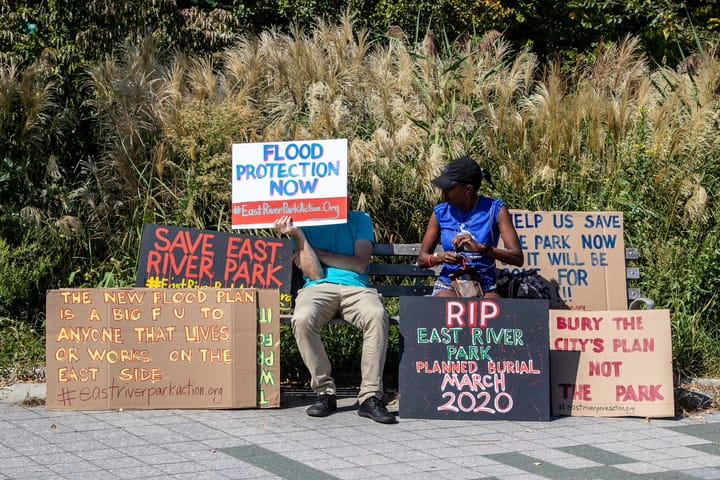Save East River Park
New York, NY, USA
“What would Jane Jacobs do?” asked one protester’s sign. “Well, I sure wouldn’t kill East River Park,” said the cartoon image of Jane Jacobs underneath.
Jane Jacobs, of course, is best known for taking on the cartoonishly-villainous Robert Moses and successfully fighting some of his plans to turn Lower Manhattan into a safe haven for the motor car. And the signmaker is probably right: it’s unlikely that Jane Jacobs would approve of the city’s current plans for East River Park.
At issue is the question of how best to defend Manhattan from future flooding. Hurricane Sandy was a wakeup call; with climate change threatening to bring both higher sea levels and more frequent and more intense hurricanes, Manhattan is at serious risk of regular and potentially-catastrophic flooding. No one who lives here doubts the urgency of building up the island’s flood defenses. The East Side Coastal Resiliency Project envisages the construction of new flood defenses running from Montgomery Street all the way up to East 25th Street, including the entirety of the popular and attractive East River Park.
The devil, however, appears to be in the details of the execution. Initial plans, developed by the Danish Bjarke Ingels Group, called for a landscaped berm that would augment rather than disrupt the park. This design took into account local community input and was generally well-received. Then, unexpectedly and apparently without consultation with local residents, the city tossed out the plans and announced their Preferred Alternative.
To say the new plan was radical would be an understatement. Gone was the modest landscaping, the respect for the existing facilities and state of the park. In its place was a proposal for a vastly more costly plan, one that would destroy the existing park entirely. Under the new plan, the entire park would be raised by eight to ten feet, with everything buried beneath eight to ten feet of landfill. All the recently-completed sports facilities – basketball and tennis courts, soccer fields, running track and more – would be destroyed. More than a thousand mature trees would be uprooted and carted away. The fate of various other much-loved features of the park is unclear. And the entire park, the only open space accessible to tens of thousands of mostly low-income residents living in adjacent public housing – would be closed for years to come (three and a half, by the city’s almost comically optimistic estimate, a minimum of five or even ten according to people with more realistic ideas about how major public works unfold).
The reasons for this abrupt about-face are still mysterious. The city has been singularly unforthcoming about why the previous plan was found lacking or why they worked up an entirely new plan without any community involvement. One widespread and apparently well-founded suspicion is that one of the strikes against the old plan was that it threatened to impinge on the sacred turf of the FDR Drive, the six-lane highway that flows down the east side of Manhattan, and that this offense against the almighty automobile could not be tolerated. Evidently, the unquiet ghost of Robert Moses still haunts the neighborhood.
Even if you take the city’s word for it that the new plans represent the only possible option, the prospect of seeing everything that has been added to the park buried under rubble, the destruction of the habitats for local wildlife, and the loss of all access to the park for an unspecified but lengthy period, is horrifying. The park is intensely used: there’s a constant traffic of runners and cyclists going up and down the greenway at the water’s edge, while during the summer people sunbathe on the lawns and local families gather for picnics and barbecues. Anglers line the esplanade to pull questionably-edible fish from the East River. The basketball and tennis courts are rarely empty. And despite the rapid gentrification of Lower Manhattan, the Lower East Side is still home to many people who don’t have easy access to other options.
There are signs that the city is belatedly backing down from its high-handed stance. A revised plan now calls for a phased approach that will leave parts of the park open even while work is done elsewhere (at the cost of extending construction time). A Dutch consultant hired by Borough President Gale Brewer and City Council member Carlina Rivera has finally turned in a report.
The Deltares Report stops short of making major changes to the plan along the lines suggested by some local residents (such as preferentially burying the FDR Drive instead and perhaps digging up the grave of Robert Moses and driving a stake through his heart as a precaution). It does fault the city for lack of transparency, and calls for interim flood protections, something that the city’s Preferred Alternative seems to have overlooked.
So it looks as if the end result may be a half-hearted compromise: not quite such a hecatomb as the original plan, but still devastating to the park. And so long as the mighty motor car is still king, the FDR Drive remains sacrosanct. Plans to deck it over or, horror of horrors, to sacrifice some of its six pollution-spewing lanes to other uses remain off the table. Which is too bad. It’s past time to re-evaluate our relationship with cars and think about alternatives, and this might have been a good opportunity to do so.
It’s what Jane Jacobs would have wanted.
